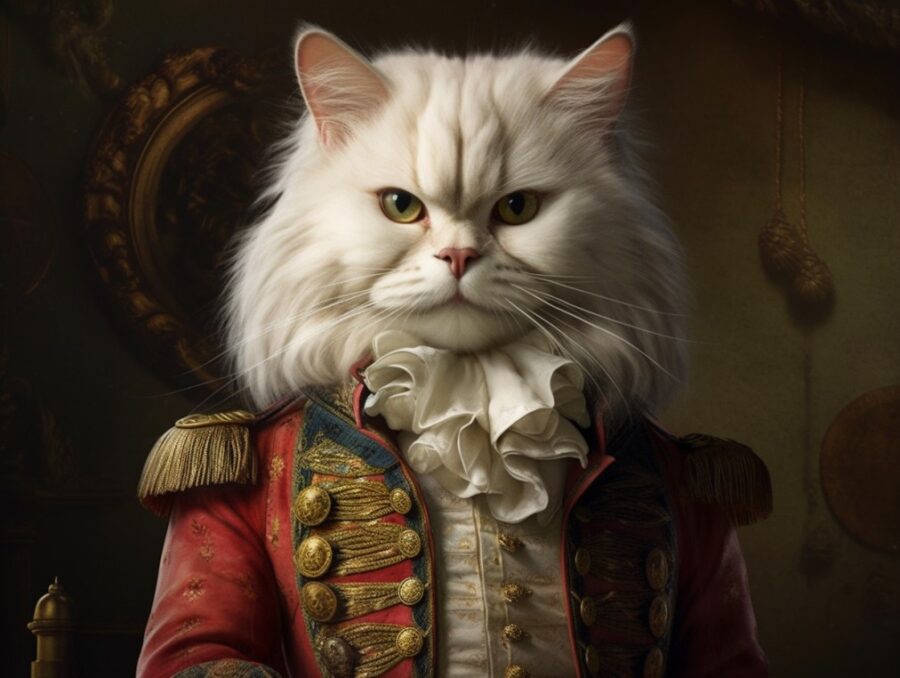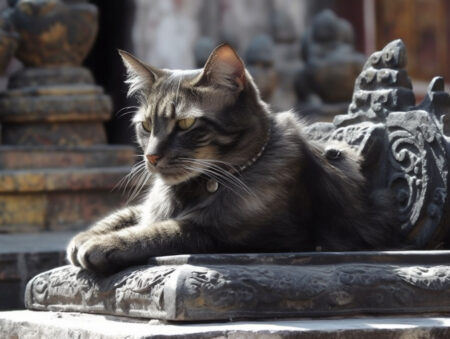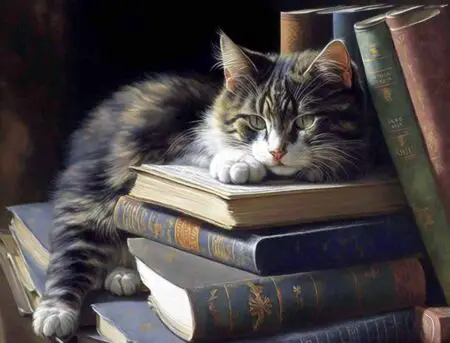Have you ever stopped to ponder the pervasive presence of cats in our stories, films, and digital media? From ancient folklore to modern internet memes, cats have consistently captured our imagination with their enigmatic allure.
So, let’s discuss the fascinating role of cats in literature and popular culture, exploring their symbolic significance and the reasons behind their enduring popularity.
Cats in Literature
Cats have played integral roles in literature across ages and cultures, often serving as symbols and metaphors that enrich the narrative and resonate with readers.
In classic literature, cats frequently symbolize mystery, independence, and sometimes, the supernatural. Edgar Allan Poe’s “The Black Cat” is a prime example. The cat is far more than a mere pet in this chilling tale of suspense, superstition, and guilt. It becomes a symbol of the protagonist’s deteriorating mental state, a haunting reminder of his guilt that ultimately leads to his downfall. This story underscores the cat’s traditional association with mystery and the unknown, highlighting its role as a powerful symbol in literature.
In children’s literature, cats often take on a more whimsical charm. T.S. Eliot’s “Old Possum’s Book of Practical Cats” is a delightful collection of feline characters, each with unique quirks and personalities. From the notorious criminal mastermind Macavity to the magical Mr. Mistoffelees, these cats captivate the imagination of young readers and adults alike. These characters were later brought to life in the famous musical, “Cats,” which has enchanted audiences worldwide with its captivating portrayal of Eliot’s feline characters.
In contemporary literature, cats continue to play significant roles, often serving as metaphysical entities that bridge reality and the subconscious. Haruki Murakami, the acclaimed Japanese author, frequently uses cats in this way in his works. In novels like “Kafka on the Shore” and “The Wind-Up Bird Chronicle,” cats serve as conduits to alternate realities, guides to the subconscious, and symbols of fate. They add layers of complexity to the narrative, enhancing the surreal and dreamlike quality of Murakami’s works.
The symbolism of cats in literature is as rich and varied as the cultures that produce these works. In many Asian cultures, cats can signify luck and prosperity. The “Maneki-Neko” or “beckoning cat” is a common talisman believed to bring good fortune and wealth. Conversely, in various European folklore, cats, particularly black ones, are often associated with witchcraft and the supernatural, reflecting age-old superstitions.
Their enigmatic nature and dual symbolism—representing good luck and dark forces—make cats compelling characters that resonate with readers. Whether serving as metaphors for complex human emotions or embodying cultural beliefs and superstitions, cats add depth and intrigue to literary works, enhancing their appeal to readers of all ages.
Cats in Literature (Video)
Notable Cats from Literature
| Cat’s Name | Source of Literature | Character Role |
|---|---|---|
| Pluto | “The Black Cat” by Edgar Allan Poe | A black cat that the narrator comes to despise and fear, symbolizing guilt and the supernatural. |
| The Cheshire Cat | “Alice’s Adventures in Wonderland” by Lewis Carroll | A grinning cat known for its ability to disappear, offering cryptic advice and philosophical musings to Alice. |
| Behemoth | “The Master and Margarita” by Mikhail Bulgakov | A large, demonic black cat who walks on two legs, talks, and is known for his love of chess and vodka. |
| Macavity | “Old Possum’s Book of Practical Cats” by T.S. Eliot | A master criminal cat who is always able to elude the authorities, known as the “Napoleon of Crime.” |
| Crookshanks | “Harry Potter” series by J.K. Rowling | Hermione Granger’s pet cat, known for his squashed face and bushy tail, who plays a key role in the plot by unmasking Scabbers the rat. |
| The Cat | “The Cat in the Hat” by Dr. Seuss | A mischievous cat who brings chaos and fun into the lives of two bored children. |
| Saha | “Kafka on the Shore” by Haruki Murakami | A missing cat whose disappearance triggers a chain of surreal events. |
| Tom Kitten | “The Tale of Tom Kitten” by Beatrix Potter | A mischievous kitten who often gets into trouble, teaching children about the consequences of disobedience. |
| Church | “Pet Sematary” by Stephen King | The family cat that’s hit by a truck and later resurrected in the “Pet Sematary,” coming back much more sinister. |
| Greebo | “Discworld” series by Terry Pratchett | Nanny Ogg’s one-eyed cat, known for his ferocious nature and later ability to transform into a human. |
| Dinah | “Alice’s Adventures in Wonderland” by Lewis Carroll | Alice’s off-screen cat, who Alice mentions several times with affection, symbolizing Alice’s longing for the comforts of home. |
| Mrs. Norris | “Harry Potter” series by J.K. Rowling | The caretaker Filch’s pet cat, known for her ability to detect rule-breaking students. |
| Socks | “Socks” by Beverly Cleary | A black cat that the narrator despises and fears, symbolizing guilt and the supernatural. |
| Carbonel | “Carbonel: The King of Cats” by Barbara Sleigh | A royal cat who enlists the help of a young girl to free him from a witch’s curse. |
| Mog | “Mog the Forgetful Cat” by Judith Kerr | A cat known for her forgetfulness, teaching children about patience and understanding. |
| Mr. Mistoffelees | “Old Possum’s Book of Practical Cats” by T.S. Eliot | A magical cat known for his spectacular tricks and ability to solve any problem. |
Cats in Popular Culture
Cats have not only made their mark in literature but have also clawed their way into the heart of popular culture. In film and television, they have taken on a variety of roles, ranging from adorable sidekicks to iconic characters. For instance, Disney’s Figaro in “Pinocchio” is a small black and white cat who is often seen as Pinocchio’s sidekick and conscience, embodying loyalty and companionship. On the other end of the spectrum, the sassy “Puss in Boots” in the “Shrek” series is a swashbuckling adventurer, known for his cunning, bravery, and irresistible charm. These characters often exhibit traits we associate with cats — independence, cunning, and a certain inscrutable charm, making them relatable and endearing to audiences.
The digital age has further elevated cats’ status in popular culture. They rule the internet, with viral videos and memes capturing millions of hearts worldwide. Grumpy Cat, with her perpetually frowning face, became an internet sensation, symbolizing our collective displeasure with the world’s annoyances. On the other hand, Keyboard Cat charmed viewers with his rhythmically gifted paws, reminding us of the internet’s ability to turn the ordinary into the extraordinary. These internet sensations have spawned a plethora of merchandise, from t-shirts to coffee mugs, and have even inspired artworks and songs, demonstrating the significant cultural impact of these feline stars.
Cats also feature prominently in Japanese anime and manga, often portrayed as cute, endearing companions with human-like intelligence. “Hello Kitty,” a global phenomenon, is a symbol of cuteness and innocence, while Luna from “Sailor Moon” serves as a guide and mentor to the protagonist, embodying wisdom and loyalty. These portrayals have significantly influenced global perceptions of cats, reinforcing their popularity as pets and status as cultural icons.
The portrayal of cats in popular culture not only reflects our fascination with these creatures but also shapes our understanding and attitudes toward them. They are at once mysterious and familiar, independent yet affectionate — a paradox that continues to fascinate us. Whether they’re making us laugh with their antics, tugging at our heartstrings with their cuteness, or inspiring us with their bravery and independence, cats have secured a special place in our cultural landscape, captivating audiences and winning hearts across the globe.
Notable Cats from Popular Culture
| Cat’s Name | Source | Reason for Popularity |
|---|---|---|
| Garfield | “Garfield” Comic Strip | Known for his love of lasagna and his lazy, sarcastic humor. |
| Tom | “Tom and Jerry” Cartoon | Famous for his comedic, never-ending pursuit of Jerry the mouse. |
| Sylvester | “Looney Tunes” Cartoon | Known for his lisp and his comedic attempts to catch Tweety Bird. |
| Hello Kitty | Sanrio | A global icon of cuteness and the face of a highly successful merchandise brand. |
| Grumpy Cat | Internet Meme | Became an internet sensation due to her unique frowning face. |
| Puss in Boots | “Shrek” Movies | Known for his swashbuckling charm and his iconic wide-eyed innocent look. |
| Figaro | Disney’s “Pinocchio” | Loved for his loyalty and companionship to Pinocchio. |
| Simba | Disney’s “The Lion King” | Known for his coming-of-age journey to become king. |
| Cheshire Cat | “Alice in Wonderland” | Famous for his mischievous grin and cryptic riddles. |
| Felix | “Felix the Cat” Cartoon | One of the first animated characters, known for his cheerful personality and magical bag of tricks. |
| Snowball | “The Simpsons” | The Simpson family’s pet cat, known for being replaced by identical cats after each untimely death. |
| Luna | “Sailor Moon” Anime | A talking cat who guides the Sailor Scouts, known for her crescent moon marking and wise counsel. |
| Jiji | “Kiki’s Delivery Service” Anime | Kiki’s talking black cat, loved for his sarcastic humor and loyalty. |
| Scratchy | “The Simpsons” (Itchy & Scratchy Show) | Known for his comedic, violent clashes with Itchy the mouse. |
| Mr. Bigglesworth | “Austin Powers” Movies | Dr. Evil’s hairless pet cat, known for his striking appearance. |
| Duchess | Disney’s “The Aristocats” | The elegant mother cat who, along with her kittens, is the focus of the movie’s adventure. |
| Tigger | “Winnie the Pooh” | A tiger-like character known for his energetic bouncing and his cheerful, carefree personality. |
| Hobbes | “Calvin and Hobbes” Comic Strip | Calvin’s anthropomorphic tiger, known for his philosophical insights and role in Calvin’s imaginative adventures. |
| Bagheera | “The Jungle Book” | A wise black panther who serves as Mowgli’s mentor and protector. |
| Keyboard Cat | Internet Meme | A cat playing a keyboard in a viral video, known for being humorously edited into the end of blooper and fail videos. |
Conclusion
From the pages of classic novels to the vibrant world of internet memes, cats have left their paw prints on literature and popular culture.
They symbolize a range of human emotions and experiences, making them relatable and captivating.
As we continue to weave stories and create media, it’s clear that cats will remain a presence, continuing to intrigue and entertain us for years.
"In ancient times cats were worshipped as gods; they have not forgotten this."
-- Terry Pratchett





